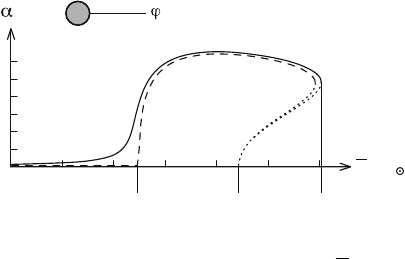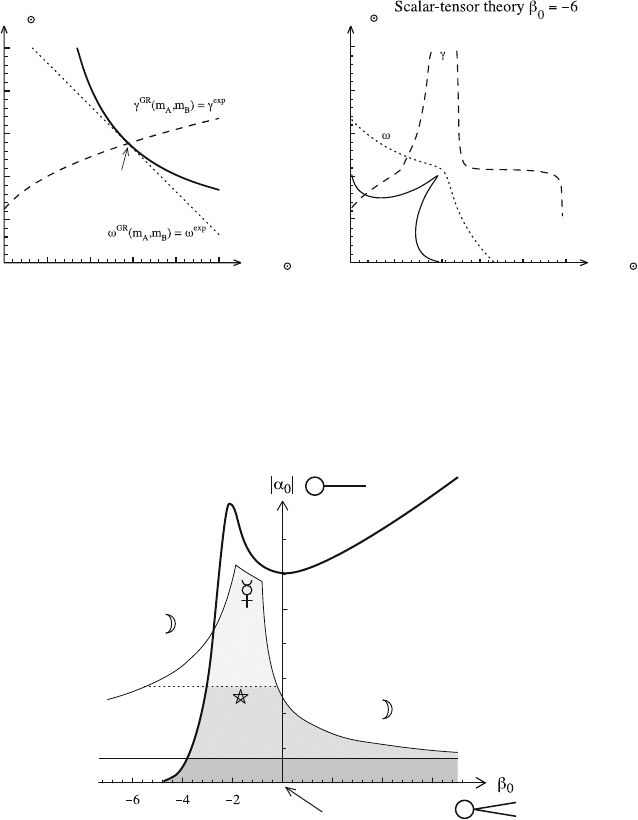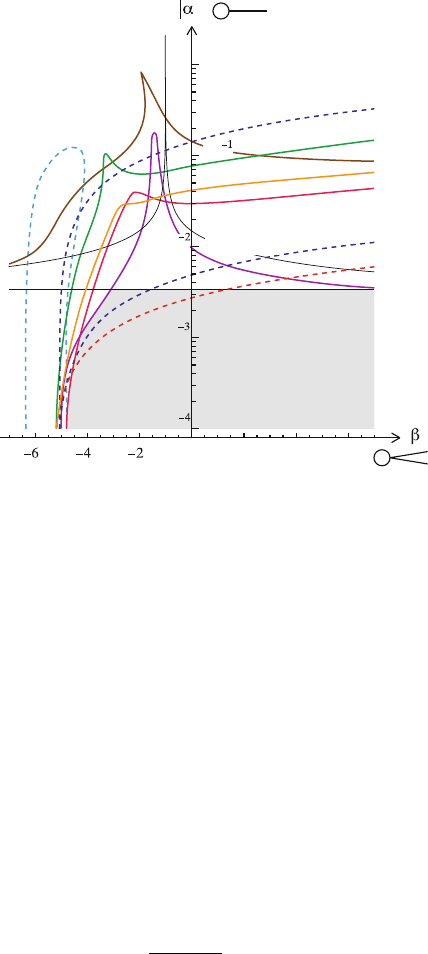Blanchet L., Spallicci A., Whiting B. (Eds.) Mass and Motion in General Relativity
Подождите немного. Документ загружается.


Motion in Alternative Theories of Gravity 471
4.2 Strong-Field Predictions
A qualitatively different class of constraints is obtained by studying scalar-tensor
theories in the strong-field regime, that is, near compact bodies whose radius R is
not extremely large with respect to their Schwarzschild radius 2Gm=c
2
. This is no-
tably the case when considering neutron stars, whose ratio Gm=Rc
2
0:2 is not
far from the theoretical maximum of 0:5 for black holes. Although the metric is very
significantly different from the flat one inside such compact bodies and in their im-
mediate vicinity, their orbital velocity in a binary system may nevertheless be small
enough to perform a consistent expansion in powers of v
2
=c
2
Gm=rc
2
,wherer
denotes the interbody distance (as opposed to their radius R). This is usually called
a post-Keplerian expansion.
2
In such a case, one can show [39,113] that the predic-
tions of scalar-tensor theories are similar to those of weak-field conditions, with the
only difference that the matter-scalar coupling constant ˛
0
and ˇ
0
are replaced by
body-dependent quantities, say ˛
A
and ˇ
A
for a body labeled A. For instance, the
effective gravitational constant describing the lowest-order attraction between two
compact bodies A and B reads now G
AB
D G
.1 C ˛
A
˛
B
/, instead of the weak-
field expression G D G
.1 C ˛
2
0
/ mentioned above. Similarly, the 1PN parameters
ˇ
PPN
and
PPN
are replaced by body-dependent ones ˇ
A
BC
and
AB
,takingthesame
forms as in Eq. 9 but where ˛
2
0
is replaced by ˛
A
˛
B
,and˛
0
ˇ
0
˛
0
by ˛
B
ˇ
A
˛
C
(see
Ref. [39] for precise expressions). All post-Keplerian effects can thus be derived
straightforwardly, in a similar way as in the solar system. In addition to these pre-
dictions, one may also compute the energy loss due to the emission of gravitational
waves by a binary system. It takes the schematic form
3
Energy
flux
D
Quadrupole
c
5
CO
1
c
7
spin 2
C
(
Monopole
c
0C
1
c
2
2
C
Dipole
c
3
C
Quadrupole
c
5
CO
1
c
7
)
spin 0
; (10)
where the first line comes from the emission of usual (spin-2) gravitons, and
the second one from the emission of scalar (spin-0) waves. Note that the dipo-
lar term is of order O.1=c
3
/, generically much larger than the standard O.1=c
5
/
quadrupoleof GR. As expected for a dipole, it vanishes when considering a perfectly
2
Two different (though related) meanings of “post-Keplerian” exist in the literature. We are here
considering a post-Keplerian expansion in powers of v
2
orbital
=c
2
, while keeping the full nonpertur-
bative dependence in the gravitational self-energy Gm=Rc
2
. On the other hand, post-Keplerian
deviations mean relativistic effects modifying the lowest-order Keplerian motion, like those de-
scribed in Section 4.3. Only this latter meaning is used in GR, because its strong equivalence
principle implies that the internal structure of a body does not influence its motion up to order
O.1=c
10
/, as recalled in Section 5.
3
The precise definitions of these multipoles and their explicit expressions may be found for in-
stance in Section 6 of Ref. [39].

472 G. Esposito-Far`ese
0.6
0.4
0.2
0
0.5 1 1.5 2 2.5 3
m
A
/m
|
A
|
Critical
mass
Maximum
mass
Maximum
mass in GR
Neutron star
Fig. 8 Scalar charge ˛
A
of a neutron star versus its baryonic mass m
A
, for the model A.'/ D
exp.3'
2
/,thatis,ˇ
0
D6. The solid line corresponds to a small value of ˛
0
(namely, the
VLBI bound of Fig. 7), and the dashed line to ˛
0
D 0. The dotted lines correspond to unstable
configurations of the star
symmetrical binary system, because there is no longer any privileged spatial
orientation. Its precise calculation [39, 113] shows indeed that it involves the
difference of the scalar charges of the two bodies, and is actually proportional to
.˛
A
˛
B
/
2
. Although the monopolar term is a priori of the even larger order
O.1=c/ for bodies which are not at equilibrium (e.g., collapsing or exploding stars),
it reduces to order O.1=c
5
/ for usual bodies, as displayed in Eq. 10, because of the
conservation of their scalar charge.
The only remaining difficulty, to derive the predictions of scalar-tensor theories
in the strong-field regime, is to compute the body-dependent coupling constants ˛
A
and ˇ
A
. This can be done thanks to numerical integrations of the field equations in-
side the bodies, as explained in [40,42,43]. For negative values of the parameter ˇ
0
entering expansion (8), one shows, both analytically and numerically, that nonper-
turbative effects occur beyond a critical compactness Gm=Rc
2
depending on ˇ
0
.
For instance, for ˇ
0
D6, the linear coupling constant ˛
A
of a neutron star to the
scalar field takes the values displayed in Fig. 8.
One sees that even if ˛
0
is vanishingly small in the background (and thereby in
the solar system), neutron stars can develop an order-one coupling constant to the
scalar field. Their physics and their orbital motion can thus differ significantly from
the predictions of GR, although the scalar field may have strictly no effect in the
solar system.
4.3 Binary-Pulsar Tests
Now that we know how to compute the predictions of scalar-tensor theories even in
strong-field conditions, how may we test them? It happens that nature has provided
us with fantastic objects called pulsars. These are neutron stars (thereby very com-
pact objects, Gm=Rc
2
0:2) which are rapidly rotating and highly magnetized,
and which emit a beam of radio waves like lighthouses. They can thus be considered
Motion in Alternative Theories of Gravity 473
as natural clocks, and the oldest pulsars are indeed very stable ones. Therefore, a
pulsar A orbiting a companion B is a moving clock, the best tool that one could
dream of to test a relativistic theory. Indeed, by precisely timing its pulse arrivals,
one gets a stroboscopic information on its orbit, and one can measure several rela-
tivistic effects. Such effects do depend on the two masses m
A
, m
B
, which are not
directly measurable. However, two different effects suffice to determine them, and
a third relativistic observable then gives a test of the theory.
For instance, in the case of the famous Hulse–Taylor binary pulsar PSR
B1913C16 [112], three relativistic parameters have been determined with great
accuracy: (i) the Einstein time delay parameter
T
, which combines the second-
order Doppler effect (/ v
2
A
=2c
2
) together with the redshift due to the companion
(/ Gm
B
=r
AB
c
2
); (ii) the periastron advance P! (/ v
2
=c
2
); and (iii) the rate
of change of the orbital period,
P
P , caused by gravitational radiation damping
(/ v
5
=c
5
in GR, but of order v
3
=c
3
in scalar-tensor theories; see Eq. 10). The same
parameters have also been measured for the neutron star-white dwarf binary PSR
J11416545, but with less accuracy [10,11]. In addition to these three parameters,
(iv) the “range” (global factor Gm
B
=c
3
) and (v) “shape” (time dependence) of the
Shapiro time delay have also been determined for two other binary pulsars, PSR
B1534C12 [103] and PSR J07373039 [31, 73, 76]. The latter system is partic-
ularly interesting because both bodies have been detected as pulsars. Since their
independent timing gives us the (projected) size of their respective orbits, the ratio
of these sizes provides a direct measure of (vi) the mass ratio m
A
=m
B
1:07.
In other words, 6 relativistic parameters have been measured for the double pulsar
PSR J07373039. After using two of them to determine the masses m
A
and m
B
,
this system thereby provides 6 2 D 4 tests of relativistic gravity in strong-field
conditions.
The clearest way to illustrate these tests is to plot the various experimental con-
straints in the mass plane .m
A
;m
B
/, for a given theory of gravity. Any theory indeed
predicts the expressions of the various timing parameters in terms of these unknown
masses and other Keplerian observables, such as the orbital period and the eccentric-
ity. The equations predictions.m
A
;m
B
/ D observed values thereby define different
curves in the mass plane, or rather different strips if one takes into account exper-
imental errors. If these strips have a common intersection, there exists a pair of
masses that is consistent with all observables, and the theory is confirmed. On the
other hand, if the strips do not meet simultaneously, the theory is ruled out. Figure 9
displays this mass plane for the Hulse–Taylor binary pulsar. Its left panel shows
that GR is superbly consistent with these data. Its right panel illustrates that the
three strips can be significantly deformed in scalar-tensor theories, because scalar
exchanges between the pulsar and its companion modify all theoretical predictions.
In the displayed case, corresponding to a quadratic matter-scalar coupling constant
ˇ
0
D6 (as in Fig. 8), the strips do not meet simultaneously and the theory is thus
excluded. On the contrary, they may have a common intersection in other scalar-
tensor theories, even if it does not correspond to the same values of the masses
m
A
and m
B
that were consistent with GR. The allowed region of the theory space
.j˛
0
j;ˇ
0
/ is displayed in Fig. 10.

474 G. Esposito-Far`ese
0
0.5 1 1.5 2 2.5
0.5
1
1.5
2
2.5
P
GR
(m
A
,m
B
) = P
exp
.
.
.
intersection
T
0
0.5 1 1.5 2 2.5
0.5
1
1.5
2
2.5
.
P
.
m
A
/m
m
B
/m
m
A
/m
m
B
/m
General relativity
T
.
T
Fig. 9 Mass plane (m
A
D pulsar, m
B
D companion) of the Hulse–Taylor binary pulsar PSR
B1913C16 in general relativity (left panel) and for a scalar-tensor theory with ˇ
0
D6 (right
panel). The widths of the lines are larger than 1 error bars. While GR passes the test with flying
colors, the value ˇ
0
D6 is ruled out. [Actually, the right panel is plotted for a specific small
value of j˛
0
j10
2
, but the three curves keep similar shapes whatever ˛
0
, even vanishingly
small, and they never have any common intersection for ˇ
0
D6]
PSR
B1913+16
0.025
0.035
0.010
0.015
0.020
0.005
0246
General Relativity
LLR
VLBI
LLR
Cassini
Fig. 10 Same theory plane .j˛
0
j;ˇ
0
/ as in Fig. 7, but taking now into account the constraints im-
posed by the Hulse–Taylor binary pulsar (bold line). LLR stands as before for “lunar laser ranging”
and VLBI for “very long baseline interferometry.” The allowed region is the dark grey one. While
solar system tests impose a small value of j˛
0
j, binary pulsars impose the orthogonal constraint
ˇ
0
> 4:5
As mentioned above, several other relativistic binary pulsars are presently
known, and Fig. 11 displays their simultaneous constraints on this theory plane
[37,42–44,55]. To clarify this plot, we have used a logarithmic scale for the vertical
(j˛
0
j) axis. The drawback is that GR, corresponding to ˛
0
D ˇ
0
D 0,issentdown

Motion in Alternative Theories of Gravity 475
B1913+16
0246
0
0
|
B1534+12
J0737—3039
SEP
LIGO/VIRGO
NS-BH
LIGO/VIRGO
NS-NS
LISA NS-BH
PSR-BH
Cassini
LLR
J1141—6545
10
0
10
10
10
10
Fig. 11 Same theory plane as in Fig. 10, but now with a logarithmic scale for the linear matter-
scalar coupling constant j˛
0
j. This plot displays solar-system and several binary-pulsar constraints,
using the latest published data. The allowed region is shaded. The curve labeled SEP corresponds to
tests of the “strong equivalence principle” using a set of neutron star-white dwarf low-eccentricity
binaries. The dashed lines corresponds to expected constraints if we find a relativistic pulsar-black
hole (PSR-BH) binary, or when gravity-wave antennas detect the coalescence of double-neutron
star (NS-NS) or neutron star-black hole (NS-BH) binaries
to infinity, but the important point to recall is that it does lie within the allowed
(grey) region. Figures 10 and 11 illustrate vividly the qualitative difference between
solar-system and binary-pulsar observations. Indeed, while weak-field tests only
constrain the linear coupling constant j˛
0
j to be small without giving much infor-
mation about the quadratic coupling constant ˇ
0
, binary pulsars impose ˇ
0
> 4:5
even for a vanishingly small ˛
0
. This constraint is due to the spontaneous scalar-
ization of neutron stars which occurs when ˇ
0
is large enough, and which was
illustrated in Fig. 8 above. Equations 9 allow us to rewrite this inequality in terms
of the Eddington parameters ˇ
PPN
and
PPN
, which are both consistent with 1 in the
solar system. One finds
ˇ
PPN
1
PPN
1
<1:1: (11)
The singular (0=0) nature of this ratio underlines why such a conclusion could not
be obtained in weak-field experiments.
476 G. Esposito-Far`ese
4.4 Black Holes in Scalar-Tensor Gravity
In Fig. 11 is displayed the order of magnitude of the tight constraint that can be
expected if we are lucky enough to detect a relativistic pulsar-black hole binary.
However, let us comment on the behavior of black holes in scalar-tensor theories.
Since we saw in Fig. 8 above that nonperturbative effects can occur in strong-field
conditions,one should a priori expect even larger deviations from GR for black holes
(extreme compactness Gm=Rc
2
D 0:5) than for neutron stars (large compactness
Gm=Rc
2
0:2). However, the so-called no-hair theorem [13, 28, 39, 60, 61, 63]
shows that black holes must have a strictly vanishing scalar charge, ˛
BH
D 0.
The basic idea is that otherwise the scalar field ' would diverge at the horizon,
and this would be an unphysical solution. A first consequence is that a collapsing
star must radiate away its scalar charge when forming a black hole. This is related
to the generically large O.1=c/ monopolar radiation of scalar waves predicted for
nonequilibrium configurations, as discussed below Eq. 10. But the second crucial
consequence is that black holes, once formed and stabilized, are not coupled at all
to the scalar field, and therefore behave exactly as in GR: They generate the same
solution for the Einstein metric g
, do not excite the scalar field ', and move
within the curved geometry of g
as in GR. The conclusion is therefore that there
is strictly no observable scalar-field effect in a binary black-hole system.
Of course, there do exist significant perturbations caused by the scalar field dur-
ing the short time of the black-hole formation or when it captures a star (see e.g.,
[32]), because of the emission of a generically large amount of energy via scalar
waves. Similarly, if one assumes that there exists a nonconstant background of scalar
field '
0
.x/, then its own energy momentum tensor T
contributes to the curva-
ture of the Einstein metric g
, and even black holes would thus indirectly feel its
presence. However, this would not be a consequence of the modification of gravity
itself, but of the assumption of a nontrivial background T
. Even within pure GR,
one could also have assumed that black holes move within a nontrivial background,
caused for instance by the presence of dark matter or some large gravitational waves,
and one would predict then a different motion than in a trivial background. One
should thus qualify our conclusion above: Given some precise boundary conditions,
for instance asymptotic flatness and no incoming radiation, black holes at equilib-
rium behave exactly as in GR.
It remains now to understand how a pulsar-black hole binary can allow us to
constrain scalar-tensor theories as in Fig. 11. The reason is that one of the two
bodies is not a black hole, but a neutron star with scalar charge ˛
A
¤ 0.Letus
even recall that massive enough neutron stars can develop order-one scalar charges
as in Fig. 8, even if matter did not feel at all the scalar field in the solar system
(˛
0
D 0). A pulsar-black hole binary must therefore emit a large amount of dipolar
waves / .˛
A
˛
BH
/
2
=c
3
D ˛
2
A
=c
3
D O.1=c
3
/,asgivenbyEq.10, and this can
be several orders of magnitude larger than the usual O.1=c
5
/ quadrupolar radiation
predicted by GR. Any pulsar-black hole binary whose variation of the orbital period,
P
P , is consistent with GR will thus tightly constrain scalar-tensor models.
Motion in Alternative Theories of Gravity 477
5 Extended Bodies
In this section, we will discuss finite-size effects on the motion of massive bodies,
in GR and in scalar-tensor theories [43, 62,87]. It is still convenient to describe the
position of such extended bodies by using one point in their interior, for instance
their approximate center of mass. In other words, we will skeletonize the extended
body’s worldtube as a unique worldline, say x
c
. However, the action (2) describing
the motion of a point particle cannot remain valid to all orders, because the metric
g
.x
left
/ on one side of the body is not strictly the same as g
.x
right
/ on the other
side. By expanding the metric around its value at x
c
, it is thus clear that an effective
action describing the motion of an extended body must depend on derivatives of
the metric, and since we wish to construct a covariant expression, such derivatives
must be built from contractions of the curvature tensor, its covariant derivatives,
or any product of them. Moreover, if the body is nonspinning and spherical when
isolated, it does not have any privileged direction, and the only 4-vector available to
contract possible free indices is the 4-velocity u
D dx
=ds of the point x
c
.The
first couplings to curvature that one may think of are thus of the form [62]
S
extended body
D S
point particle
C
Z
k
1
R C k
2
R
u
u
C
cds; (12)
where k
1
and k
2
denote body-dependent form factors (no term R
u
u
u
u
is
written since it vanishes because of the symmetry properties of the Riemann ten-
sor). However, as recalled in [25,43], any perturbative contribution to an action, say
SŒ , which is proportional to its lowest-order field equations, ıS=ı , is equivalent
to a local field redefinition. Indeed, SŒ C " D SŒ C "ıS=ı C O."
2
/,where
the small quantity " may be itself a functional of the field . Therefore, up to local
redefinitions of the worldline x
c
and the metric g
inside the body, which do not
change the observable effects encoded in the metric g
.x
obs
/ at the observer’s loca-
tion, one may replace R and R
in action (12) above by their sources. Outside the
extended body, such couplings to R or R
have thus strictly no observable effect
(see [25] for a discussion of the field redefinitions inside the body even when it is
skeletonized as a point particle).
The first finite-size observable effects must therefore involve the Weyl tensor
C
, which does not vanish outside the body. Because of the symmetry properties
of this tensor, the lowest-order terms one may construct from it take the form [62]
S
extended body
D S
point particle
C
Z
k
3
C
2
C k
4
C
˛
C
ˇ
u
˛
u
ˇ
Ck
5
C
˛ˇ
C
ı
u
˛
u
ˇ
u
u
ı
C
cds: (13)
By comparing the dimensions of S
point particle
D
R
mc ds and these couplings to
the Weyl tensor, we expect kC
2
m and therefore k mR
4
E
(where k denotes
any of the form factors k
3
, k
4
,ork
5
,andR
E
means the radius of the extended
body, here written with an index to avoid a confusion with the curvature scalar).

478 G. Esposito-Far`ese
In conclusion, for a compact body such that Gm=R
E
c
2
1, we expect the form
factors k to be of order m.Gm=c
2
/
4
, and the corrections to its motion will be pro-
portional to kc
2
C
2
D kc
2
O.1=c
4
/ D O.1=c
10
/. Therefore, finite-size effects start
at the fifth post-Newtonian (5PN) order, consistently with the Newtonian reasoning.
Indeed, if one considers two bodies A and B that are spherical when isolated, one
can show that B is deformed as an ellipsoid by the tidal forces caused by A,and
this deformation induces an extra force .Gm
A
=r
2
AB
/.R
B
=r
AB
/
5
felt by A.IfB
is a compact body, that is, Gm
B
=R
B
c
2
1, one concludes that the extra force felt
by body A is of order O.1=c
10
/. We recovered above the same conclusion within
GR thanks to a very simple dimensional argument. Note however that the explicit
calculation is more involved than our estimate of the order of magnitude, because
one must take into account the Weyl tensor generated by the two (or more) bodies
of the system.
Let us now follow the same dimensional reasoning within scalar-tensor theories
of gravity. We assumed in Eq. 7 that matter is coupled to the physical metric g
D
A
2
.'/g
, therefore the action of a point particle reads
S
point particle
D
Z
mc
q
g
dx
dx
D
Z
A.'/mc
q
g
dx
dx
: (14)
When studying the motion of such a point particle in the Einstein metric g
,itbe-
haves thus as if it had a scalar-dependent mass m
.'/ A.'/m. [Incidentally, this
provides us with another definition of the scalar charge, ˛ D d ln m
.'/=d'.] If we
consider now an extended body in scalar-tensor gravity, the function m
.'/ must be
replaced by a functional, that is, it can depend on the (multiple) derivatives of both
the metric and the scalar field. Let us restrict again our discussion to nonspinning
bodies that are spherical when isolated. Then the derivative expansion of this mass
functional can be written as [43]
mŒ'; g
D m.'/ C I.'/R
C J.'/R
u
u
C K.'/
' C L.'/r
@
' u
u
CM.'/@
'@
' u
u
C N.'/g
@
'@
' C; (15)
where star indices mean that we areusingtheEinsteinmetricg
to compute curva-
ture tensors, covariant derivatives, and the unit velocity u
dx
=ds
,andwhere
I.'/,...,N.'/ are body-dependent form factors encoding how the extended body
feels the various second derivatives of the fields ' and g
. Fortunately, by using
as in GR the lowest-order field equations together with local field and worldline
redefinitions, this long expression reduces to a mere
mŒ'; g
D m.'/ C N
new
.'/g
@
'@
' C higher post-Keplerian orders; (16)
where N
new
.'/ is a linear combination of the previous N.'/, L.'/ and I.'/.Weal-
ready notice that the lowest-order finite-size effects involve only two derivatives
of the scalar field, whereas action (13) in GR involved the square of a second
derivative of the metric. As above, let us invoke dimensional analysis to deduce

Motion in Alternative Theories of Gravity 479
that N
new
mR
2
E
,whereR
E
still denotes the radius of the extended body. This is
consistent with the actual calculation performed in [87] for weakly self-gravitating
bodies, where it was proven that N
new
D
1
6
ˇ
0
.Inertia moment/. For compact
(therefore strongly self-gravitating) bodies, such that Gm=R
E
c
2
1, one thus ex-
pects observable effects of order Nc
2
.@'/
2
D O.1=c
2
/R
2
E
D O.1=c
6
/,thatis,
of the third post-Newtonian (3PN) order. Finite-size effects are thus much larger in
scalar-tensor theories
4
than in GR, where they were of the 5PN order, O.1=c
10
/.
Moreover, when nonperturbative strong-field effects develop as in Fig. 8, one actu-
ally expect that N
new
ˇ
E
.Inertia moment/ can be of order unity, because the
coupling constant ˇ
E
of the body to two scalar lines can be extremely large with
respect to the bare ˇ
0
. Therefore, finite-size effects in scalar-tensor gravity should
actually be considered as first post-Keplerian, O.v
2
orbital
=c
2
/, perturbations of the
motion, as compared to the 5PN order in GR.
6 Modified Newtonian Dynamics
The existence of dark matter (a pressureless and noninteracting fluid detected only
by its gravitational influence) is suggested by several observations. For instance,
type-Ia supernova data [7, 72, 90, 105] are consistent with a present acceleration of
the expansion of the Universe, and tell us that the dark energy density should be of
order ˝
0:7. On the other hand, the position of the first acoustic peak of the
cosmic microwave background spectrum [101,102] is consistent with a spatially flat
Universe, that is, ˝
C ˝
matter
1. Combining these two pieces of information,
one thus deduce that the matter density should be ˝
matter
0:3, a value at least one
order of magnitude larger than all our estimates of baryonic matter in the Universe
(for instance ˝
baryons
0:04 derived from Big Bang nucleosynthesis). Therefore,
most of the cosmological matter should be nonbaryonic, that is, “dark” because it
does not interact significantly with photons. Another, independent, evidence for the
existence of dark matter is the flat rotation curves of clusters and galaxies [91]: The
velocities of outer stars tend toward a constant value (depending on the galaxy or
cluster), instead of going asymptotically to zero as expected in Newtonian theory
(recall that Neptune is much slower than Mercury in the solar system). If Newton’s
law is assumed to be valid, such nonvanishing asymptotic velocities imply the ex-
istence of much more matter than within the stars and the gas. Independently of
4
These larger finite-size effects are due to the fact that a spin-0 scalar field can couple to the
spherical inertia moment of a body, contrary to a spin-2 graviton. They should not be confused
with the violation of the strong equivalence principle, which also occurs in scalar-tensor theories
because all form factors m.'/, N.'/, . . . depend on the body’s self-energy. Regardless of its finite
size, the motion of a self-gravitating body in a uniform exterior gravitational field depends thus on
its internal structure.

480 G. Esposito-Far`ese
these experimental evidences, we also have many theoretical candidates for dark
matter, notably the class of neutralinos occurring in supersymmetric theories (see
e.g., [26]), and numerical simulations of structure formation have obtained great
successes while incorporating dark matter (see e.g., [64]).
However, this unknown fluid might actually be an artifact of our interpretation of
experimental data with a Newtonian viewpoint. It is thus worth examining whether
the gravitational 1=r
2
law could be modified at large distances, instead of invoking
the existence of dark matter. In 1983, Milgrom realized that galaxy rotation curves
could be fitted with a very simple recipe, that he called Modified Newtonian Dy-
namics (MOND) [79]. It does not involve any mass scale nor distance scale, but an
acceleration scale denoted as a
0
(not to be confused with the linear matter-scalar
coupling constant ˛
0
, defined in Eq. 8). Milgrom assumed that the acceleration a of
a test particle caused by a mass M should read
a D a
N
D
GM
r
2
if a>a
0
;
a D
p
a
0
a
N
D
p
GM a
0
r
if a<a
0
;
(17)
where a
N
denotes the usual Newtonian expression. This phenomenological law
happens to fit remarkably well galaxy rotation curves [95], for a universal con-
stant a
0
1:2 10
10
m s
2
. [However, galaxy clusters require either another
value of this constant, or some amount of dark matter, for instance in the form of
massive neutrinos.] Moreover, it automatically recovers the Tully–Fisher law [106]
v
4
1
/ M ,whereM denotes the baryonic mass of a galaxy, and v
1
the asymptotic
velocity of visible matter in its outer region. The MOND assumption (17) would also
explain in an obvious way why dark matter profiles seem to be tightly correlated to
the baryonic ones [77].
However, reproducing the simple law (17) in a consistent relativistic field theory
happens to be quite difficult. As mentioned in Section 2, Milgrom explored “mod-
ified inertia” models [80, 81], in which the action of a point particle is assumed to
depend nonlocally on all the time derivatives d
n
x=dt
n
of its position x. In these lec-
ture notes, we focus on local field theories which “modify gravity”, that is, which
assume that the kinetic term of the metric g
(to which matter is universally cou-
pled) is not the standard Einstein–Hilbert action (1).
6.1 Mass-Dependent Models?
It is actually very easy to devise a model predicting a force / 1=r. Indeed, let us
consider a mere scalar field ' in flat spacetime, with a potential V.'/ D2a
2
e
b'
,
where a and b are two constants. In a static and spherically symmetric situation,
its field equation ' D V
0
.'/ then gives the obvious solution ' D .2=b/ ln.abr/.
